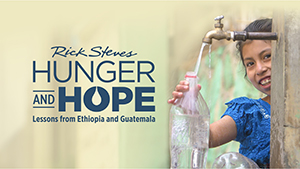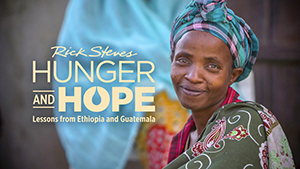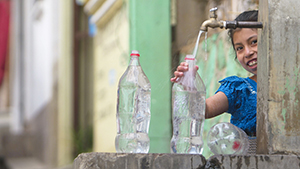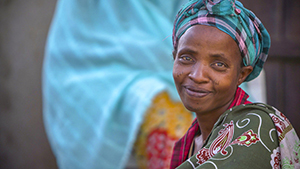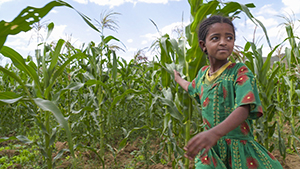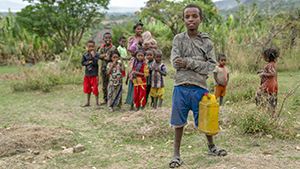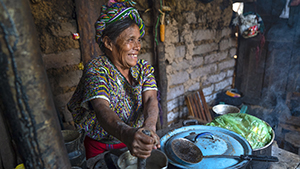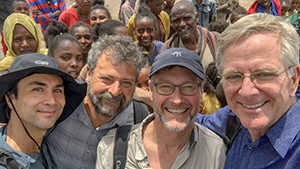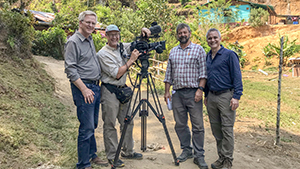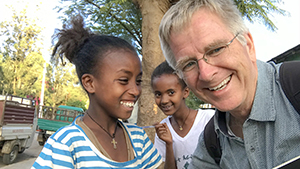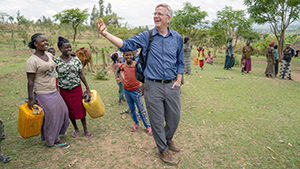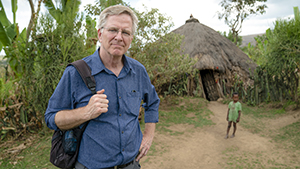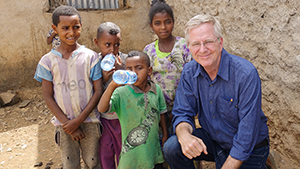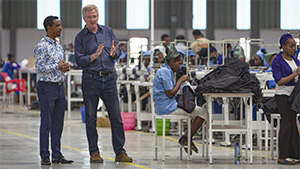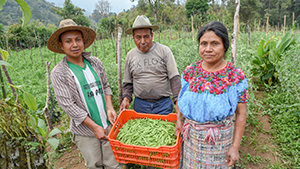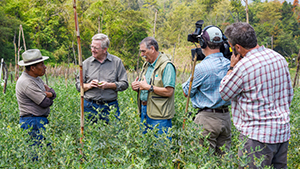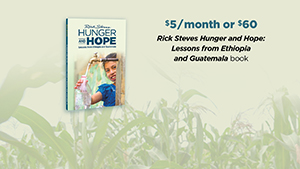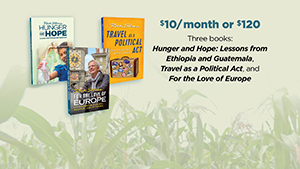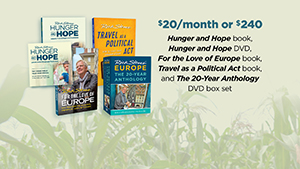Hunger and Hope: Lessons from Ethiopia and Guatemala Special (and Pledge Event)
In this 90-minute pledge event (also an hour-long special, Rick Steves travels through Ethiopia and Guatemala to learn about extreme poverty — the more than 700 million people who struggle to live on less than $2 a day. Ending hunger is possible. And, with travel as our classroom, we'll learn about innovative solutions, including the importance of water access, education, empowering women, and smart development aid.
Special length: 56 minutes. Release: February 2021. Pledge event length: approximately 90 minutes, interspersed with fundraising breaks.
Promotional Tool Kit
Program Descriptions
RICK STEVES HUNGER AND HOPE: LESSONS FROM ETHIOPIA AND GUATEMALA
(RSEG, 1/60, TV-PG, Stereo, CC)
Release: February 2020
Rick Steves Hunger and Hope: Lessons from Ethiopia and Guatemala [30 words]
In this hour-long special, Rick Steves travels through Ethiopia and Guatemala to learn about extreme poverty and its solutions, including smart development aid, empowering women, child nutrition, and education.
Rick Steves Hunger and Hope: Lessons from Ethiopia and Guatemala [60 words]
In this hour-long special, Rick Steves travels through Ethiopia and Guatemala to learn about extreme poverty — the more than 700 million people who struggle to live on less than $2 a day. Ending hunger is possible. And, with travel as our classroom, we'll learn about innovative solutions, including the importance of water access, education, empowering women, and smart development aid.
Rick Steves Hunger and Hope: Lessons from Ethiopia and Guatemala [123 words]
In this hour-long special, Rick Steves ventures beyond Europe. Traveling through Ethiopia and Guatemala, he learns from locals and experts about key aspects of extreme poverty and how to beat it. Together, we'll witness the importance of water, education, empowering women, and nutrition during a child's first 1,000 days. And we'll see firsthand the impact of globalization and the effects of climate change. More than 700 million people remain in extreme poverty — struggling to live on less than $2 a day. But with the help of innovative solutions and smart development aid, world hunger has been cut in half in the last generation. Ending hunger is possible. And, with travel as our classroom, we can learn about both the challenges and the solutions.
Promotional Media
Select "Download Image" then right-click on the image and select "Save Image As...".
Program title image. Download image
Alternate program title image. Download image
Girl filling a water bottle in San Pablo La Laguna, Guatemala. (Photo: Sean F. White ) Download image
World Food Programme health post near Hawassa, Ethiopia. (Photo: Sean F. White) Download image
Farm outside of Axum, Ethiopia. (Photo: Sean F. White) Download image
Child making the trek to fill a water bottle near Hawassa, Ethiopia. (Photo: Sean F. White) Download image
Woman preparing food in Agros International's El Paraiso community in Nebaj, Guatemala. (Photo: Sean F. White) Download image
Cameraman Sean White, producer Simon Griffith, cameraman Karel Bauer, and Rick with villagers in Ethiopia. Download image
Rick and TV crew with Chris Megargee of Agros International, in El Paraiso, Guatemala. (Photo: Agros International) Download image
Rick with new friends in Axum, Ethiopia. Download image
Rick takes a break from filming in a village outside of Hawassa, Ethiopia. (Photo: Sean F. White) Download image
Rick in a village near Hawassa, Ethiopia. (Photo: Sean F. White) Download image
Rick with village kids in Ethiopia's Tigray region. Download image
Rick learning about Ethiopia's growing economy at the Hawassa Industrial Park. (Photo: Sean F. White) Download image
With help from an NGO, Pedro owns his land in Guatemala — and manages a profitable snap pea farm. (Photo: Agros International) Download image
Rick, his crew, and a translator "walk through money" on Pedro's snap pea farm in Guatemala. (Photo: Agros International) Download image
Pledge Event: Premium Levels
Read a full description of the items by clicking to their product pages in our Travel Store.
$60 (or $5 per month) Level
- Rick Steves' Hunger and Hope: Lessons from Ethiopia and Guatemala book*
- Station Kit cost: $4.00
- Fair market value: $9.99
- Item #: ZZ-RSE-HH60
$120 (or $10/month) Level
- Rick Steves' Hunger and Hope: Lessons from Ethiopia and Guatemala book*
- Rick Steves' Travel as a Political Act book
- Rick Steves' For the Love of Europe book
- Station Kit cost: $18.00
- Fair market value: $43.98
- Item #: ZZ-RSE-HH120
$240 (or $20/month) Level
- Rick Steves' Hunger and Hope: Lessons from Ethiopia and Guatemala book*
- Rick Steves' Hunger and Hope: Lessons from Ethiopia and Guatemala DVD
- Rick Steves' Travel as a Political Act book
- Rick Steves' For the Love of Europe book
- Rick Steves' Europe: The 20-Year Anthology DVD box set
- Station Kit cost: $40.00
- Fair market value: $143.97
- Item #: ZZ-RSE-HH220
*Rick Steves' Hunger & Hope: Lessons from Ethiopia and Guatemala companion book Item #: ZZ-MAIL-HH
80-pages of stories, insights, behind-the-scenes notes, and stunning color photographs from the shoot of Rick's Hunger and Hope TV special.
Questions: [email protected]
To order, please contact:
[email protected]
Tel: 425-771-8303 ext. 240
Fax: 425-771-0833
Stations pay all shipping charges.
Pledge Event: Premium Images
Download composite JPEGs (below) of each pledge level, formatted for a 1920 x 1080 screen.
$60 Level: Download screen image
$120 Level: Download screen image
$240 Levels: Download screen image
Download a layered Photoshop file containing each pledge level as an editable group.
Download high resolution JPEGs of all pledge premiums for use in your own layouts.
Q&A with Rick Steves
How would you describe your documentary on hunger?
In this hour-long special, I venture beyond Europe. Traveling through Ethiopia and Guatemala, I learn from locals and experts about key aspects of extreme poverty and how to beat it. Through the eyes of locals, we see the importance of nutrition during a child's first 1,000 days, clean water, education, and empowering women. And, walking with Ethiopians and Guatemalans, we'll see firsthand the impact of globalization and the effects of climate change. Worldwide, more than 700 million people remain in extreme poverty — struggling to live on less than $2 a day. But with the help of innovative solutions and smart development aid, world hunger has been cut in half in the last generation. Ending hunger is possible. And, with travel as our classroom, this documentary is designed to help us learn about both the challenges and the solutions.
What inspired you to produce a special on extreme poverty?
I've been interested in the structural roots of poverty since my student travel days. Over the years, I've made several trips to developing countries — specifically to learn about why, in a world of such abundance, people go hungry. I wanted to distill into one hour the most important lessons in the fight against world hunger — to get people up to date on how smart and effective modern development aid has become. I sought to teach what extreme poverty looks like, what's causing it, what's working to fight it, and why investing in the fight to end hunger is a good and practical investment.
Why did you select Ethiopia and Guatemala as the filming locations?
While Ethiopia and Guatemala would each be fine destinations for a travel show, I chose these countries (knowing I'd ignore their touristic attractions) because they would make a good classroom to show extreme poverty, the root causes of poverty, and how development aid — combining support from rich nations and smart nongovernmental organizations (NGOs) working with committed locals to kindle development — is getting traction. I also wanted two telegenic countries, one in Africa and one in Latin America, thinking such a mix would be more entertaining to watch for an hour.
Among African countries, Ethiopia is a great example of a country making steady progress in lifting itself out of poverty. (And, with the help of the Gates Foundation, I could enjoy relatively wide and easy access to development work in progress.) In Latin America, I wanted a country with a big indigenous population and one with a glaring gap between its elites and its poor masses. Guatemala was the perfect fit. In Guatemala, I had a long-standing relationship with the Center for Global Education and Experience of Augsburg University in Minneapolis, and I knew of an array of good NGOs that would welcome our cameras. Also, in both countries, the United Nations World Food Program was hard at work and happy to provide access to their field projects.
What makes this documentary different from other projects that explore global hunger or extreme poverty?
"Hunger and Hope: Lessons from Ethiopia and Guatemala" is five minutes of desperation and 55 minutes of hope. I didn't want a program that wallowed in the all-too-common theme of guilt and hopelessness. By showing what's working, I wanted our viewers to be inspired and hopeful.
"Hunger and Hope's" distinctively optimistic tone challenges viewers to rethink how we view and address extreme poverty and development aid. Rather than focusing on charity and well-meaning but outmoded development projects, "Hunger and Hope" shows smart and modern development work: how NGOs are empowering communities to pull themselves out of extreme poverty and gain independence. Working closely with development professionals in the field, and making sure locals had a clear voice in the teaching, this special shows the important role that clean water, education, nutrition, and women's empowerment play in ending hunger. The success stories from locals are inspiring and enlightening.
What surprised you the most when creating this project?
While I felt awkward dropping in on struggling people (being a privileged, wealthy, white male from the developed world), I felt no anger or edge from the people we met, learned from, and filmed. The gentleness, warmth, and welcome we generally received from people who were quite poor materially — people both in the countryside and in the big cities — was striking. I was also impressed by the awareness that struggling locals had of the global economy. In both countries, locals we met wanted to work hard, produce, and sell things — they wanted to be allowed into the global economy. The Guatemalan dream seemed to be to stay there and work, rather than immigrate to the US (where they don't like the food).
Do you plan on continuing to create specials on your travel experiences outside of Europe?
I enjoy sharing the lessons travel can teach us about timely issues in which smart and caring Americans would be steep on the learning curve. Topics like Iran, the Holy Land, European fascism, the importance of the Protestant Reformation, and hunger all seemed to me perfect subjects for an hour-long TV special designed for a smart and caring public television audience. While these have taken me beyond Europe, my teaching focus will continue to be Europe. And my mission as a travel writer and TV producer is to inspire Americans to travel beyond their comfort zones and come home with a better understanding of and empathy for the other 96 percent of humanity. I see Europe as Americans' wading pool for world exploration. While I may stray from that beat if a subject grabs my interest, I plan to stay focused on producing travel shows in Europe.
What do you hope this project ultimately achieves?
By traveling to Ethiopia and Guatemala to scout and produce this special, I gained a better appreciation of what extreme poverty is, how smart modern development aid creates independence rather than dependence, and how working to overcome hunger is a practical and totally realistic goal. That's what this TV special is all about. And that's what I hope our viewers will learn.
In producing it, I hoped to make these points clear: Hunger is beatable. Modern aid from the rich world is a smart investment. And every American citizen — whether motivated by "love thy neighbor" or just by a desire to live in a safer and more stable world — can make a difference. I hope to inspire people to get involved, either by supporting an NGO that tickles their philanthropic fancy or by supporting an advocacy organization (like Bread for the World) that lobbies in Congress for hungry people and those in extreme poverty. In a nutshell: Ending hunger in our lifetime is a good and realistic goal, we're on a good track to make that happen, and with well-funded NGOs and the support of the US government, we can see that day in our lifetime.
What challenges did writing the script present?
You can only fit 6,000 words into an hour-long script. It was frustrating not to be able to cover things in more depth; several topics I wanted to discuss just couldn't fit (like migration, remittances, the impact of Chinese investment in the developing world, and the knee-jerk cynical reaction many people have to development aid). But the program is dense as it is, and I think it just about maxes out the ability of even the most committed viewer to stay focused and absorb all that's covered. Every word earns its place.
This script has been percolating in my mind for a couple of decades, and since then, the issues have changed. "Third World" debt is no longer a big deal, and antimalarial initiatives like mosquito nets are old news. New issues include the rise of gangs in Central America and the impact of climate change on poor farmers.
I was keenly aware of the issue of white privilege, and we decided to acknowledge that at the top of the program (actually filming in Seattle and in my home for a couple minutes). Also, public television has very high standards about not being "advocacy journalism" and not having a "call to action." We were careful not to shoot ourselves in the foot in that regard. Station programmers in all 50 states view the program before putting it on their air, and I wanted to earn the support of each of them — especially those in more conservative regions. We embraced globalization as a reality and addressed issues of development in hard business and economic terms. We were sure to use more local voices and less of my voice when illustrating important points.
Making the show engaging while appropriately serious was important. My style is a bit sprightly for a show on this topic, and we snuck in a couple of light moments (including one lonely joke). But the hour really is a 60-minute primer on the economics and the humanity of hunger.
What was the filming process like?
While I had traveled extensively in the developing world before this project, I had only briefly been in Guatemala and never traveled in Ethiopia before. My three-week scouting trip, with expert guiding by local professionals in each country, was critical. I visited a long list of projects and sights in order to vet each and decide which would be in the actual show. (Many I visited did not make the cut.) We then returned with the crew a few months later with a pretty solid script and a clear list of organizations to visit and feature. I was impressed by how stable that world was: What I saw and who I met during the scouting trip were all exactly what we saw and who we met when I returned with our crew.
For the actual shoot, we were in the field for about nine days in each country. The flight from Guatemala City to Addis Ababa (which I've done twice in the last year) was long — not one I'm eager to repeat. The biggest mishap of the entire shoot was when half our gear got stranded somewhere between the two countries for four or five days. We stayed healthy, everything worked well, our local fixers in each country were brilliant, and the red tape and filming permissions went smoothly. Getting permission was pretty simple in Guatemala, while Ethiopia was much more involved. (But, working with the Gates Foundation, Ethiopia went very smoothly.) While we normally film with a crew of three (me, producer, and cameraman), for this production we were four, adding a second camera. While we occasionally had trouble keeping crowds out of our viewfinder, the people we encountered were nearly always welcoming (and there were generally a couple children eager to be honorary crew members and carry our tripod). We filmed in April, and because nearly everywhere we went was a mile high, the weather was a dry and comfortable heat — sunny and in the 70s or 80s — and bugs were no issue.
What initiatives are you taking to support the program and help it get the traction you envision?
The "profit" for this project is measured entirely in awareness raised. Because we own all the rights to the program and our hope is to raise as much awareness as possible with it, we intend to do whatever we can to have it widely viewed. It will run its course on public television (where it has enjoyed our best carriage ever — airing in every major city in the US). Then, after a break, it'll re-air as a pledge drive or membership special (helping stations generate income during pledge season). I've produced an 80-page companion book, with beautiful and inspiring photographs and triple the verbiage of our 6,000-word script, as a thank-you gift for those calling in to donate to their local public TV stations.
The program is also designed to be a teaching aid for any organization in the US fighting hunger and extreme poverty, to use as they like. We already have a team (including the UN World Food Program, the Gates Foundation, World Vision, Bread for the World, and the Lutheran Church, among others) that are working to bump up viewership, host viewing parties, and use the program or parts of it in their promotional work. My hope is that it will be used in schools and universities as an introduction to this topic. "Hunger and Hope" has been cut into 10 short video clips for teachers to use (easily accessible by searching "hunger" at Classroom Europe). The entire program is streaming for free at ricksteves.com and a PDF of the 80-page "Hunger and Hope" book is also available free at ricksteves.com.
What Can You Do?
View and share short video clips on these topics.
I've broken the entire Hunger and Hope special into short, simple, straightforward video clips that you can use in your classroom, your congregation, your Facebook page, or anywhere you want to help raise awareness and understanding of this complex issue. Visit Rick Steves Classroom Europe and enter "Hunger" into the search box.
Read a book about global poverty.
Here are four titles I found especially helpful:
- Understanding Global Poverty (Serena Cosgrove and Benjamin Curtis). While this reads like a textbook, it was a huge help for me as I gathered ideas before writing my script and embarking on this shoot. Serena and Benjamin analyze poverty, teach why it's pervasive across human societies, and demonstrate how it can be reduced through proven policy solutions.
- The End of Poverty (Jeffrey Sachs). While a few years old now, this book makes a great case for why we need smart aid. Sachs introduces his readers to development theory, illustrates his points using real-life situations around the world, and inspires you to be part of the solution to extreme poverty.
- First 1,000 Days (Roger Thurow) tracks four pregnant women in four corners of the world — Uganda, Guatemala, India, and Chicago — and explains the importance of proper nutrition for these women and their newborns' first two years of life. By taking us into the lives of these families, Thurow teaches the science, economics, and politics of malnutrition.
- Factfulness (Hans Rosling, Anna Rosling Ronnlund, and Ola Rosling). This book's subtitle, "Ten Reasons We're Wrong About the World — and Why Things Are Better Than You Think," says it all. If asked simple questions about poverty and global trends, we generally get the answers wrong. Factfulness explains why and helps us better understand the challenges and opportunities we have in fighting hunger.
Download the Hunger and Hope companion book.
The experience of making this special was so powerful that I wanted to share even more information, insights, and behind-the-scenes notes than we could fit in a single special. I wrote this booklet in one inspired week after returning from the shoot, and it features stunning photography throughout. Download the PDF and use it any way you like.
Throw a screening party.
A great way to make a difference is to share this TV special (designed to be the most instructive hour anywhere on the fight against extreme poverty and hunger) with a group — perhaps your school, where you worship, your book club, or a circle of friends. Be sure to check out the discussion questions below.
Share your thoughts with your member of Congress.
Your congressperson works for you — and they listen. One of my favorite examples of this: Years ago, a group of friends in Alabama made an appointment to meet with their Republican congressman, Spencer Bachus. They explained to him how the extreme indebtedness of the poorest countries to the richest countries was keeping the most desperate people on the planet impoverished. Congressman Bachus learned from his constituents, and spearheaded an initiative that ultimately led to the forgiveness of billions of dollars in developing-world debt — helping to free many countries from extreme poverty.
I believe one of the most powerful things an individual can do is to simply let their congressperson know how they feel about an important issue. In fact, speaking up this way is good citizenship. While you can support various advocacy organizations, you can also simply write a letter to your member of Congress. Tell them you watched this TV special, and explain how you feel about government policy as it relates to extreme poverty. Whether you see it as an issue of morality, national security, or simple pragmatism, your voice will be heard, and you will make a difference.
Support recommended organizations.
See a list of organizations below that we worked with to produce the special, as well as others I support.
Organizations that Fight Hunger
I see smart development aid and advocacy organizations as not charities, but as services. If I'm inspired to make a difference, I invest in them, and they put my money into action. I hire them to help me make a difference. They give my compassion traction.
Part of the joy of philanthropy is what I call "vicarious consumption." Investing a bit of your disposable income smartly in helping struggling people break out of poverty will bring them far more joy than if you just consumed that extra money yourself. Those enlightened enough to "consume" that joy vicariously — by giving it to our planet's neediest people become richer than they ever could by using it themselves.
Another enjoyable part of philanthropy is that you can direct your money to your choice of causes. If you care about water issues, you can help dig a well for a thirsty village. If you like to give hardworking entrepreneurs a jumpstart, you can invest in microlending. If you thrill at the thought of helping a landless peasant get legal title to his or her land, you can support groups that specialize in this cause. And if you wish our government had policies that created less rather than more poverty, you can support a group that advocates (or lobbies) in Congress to end hunger.
Here are a few organizations that I support, and that I believe are worth considering:
Agros International
Agros helps families in Central America break the cycle of rural poverty through land ownership, market-led agriculture, financial empowerment, and health and wellbeing.
Bread for the World
Bread for the World is an advocacy organization in Washington, DC, that speaks up for hungry people. By mobilizing public opinion and lobbying in Congress, they work to end hunger at home and abroad.
Center for Global Education and Experience
CFGEE (at Augsburg University) organizes educational tours (mostly for student groups, institutions, and non-profit groups) to help concerned Americans learn first-hand about poverty and injustice, mostly in Central America. While I've joined a number of their "educational tours," other similar companies offer tours for the general public.
Citizens' Climate Education
Citizens' Climate Education is an advocacy organization that educates policymakers and the public about smart solutions to climate change.
ELCA World Hunger
Working with Lutheran churches around the world, ELCA World Hunger supports sustainable solutions that get at the root causes of hunger and poverty. They offer health clinics, microloans, community meals, advocacy, and more.
Food 4 Farmers
Food 4 Farmers works with coffee farmers to create thriving food hubs, diversify income, and implement sustainable farming practices that promote biodiversity and ecosystem resiliency throughout Latin America.
Friendship Bridge
Friendship Bridge is one of many good organizations that provide microloans to hardworking entrepreneurs in the developing world. In particular, they create opportunities that empower poor women in rural Guatemala to build a better life through microfinance, education, and health care.
Growing Hope Globally
Growing Hope Globally works with farmers and community groups in the US to fight hunger in developing countries.
Project Concern International
Project Concern International provides communities in the developing world with the tools to lift themselves out of poverty. They focus on health, self-sufficiency, sustainability, and addressing root causes.
Rainforest Action Network
Rainforest Action Network works to preserve forests, protect the climate, and uphold human rights by challenging corporate power and systemic injustice.
Rainforest Alliance
The Rainforest Alliance works with rural communities in over 60 countries to conserve forests and support sustainable livelihoods.
Sustainable Harvest International
Sustainable Harvest International partners with smallholder farming families to improve their well-being through climate-smart farming.
United Nations World Food Programme
The WFP (the largest humanitarian relief organization in the world) welcomes donations as it works in Guatemala, Ethiopia, and throughout the Global South to bring health services to remote communities, promote child nutrition and hygiene, and provide other basic needs to help promote smart development.
Water 1st International
Water 1st International's motto is "give water, give life." This Seattle-based organization supports sustainable water and toilet projects that improve health, create opportunity, and break the cycle of poverty in the world's poorest communities.
World Vision
Since 1950, World Vision has been working to pull up the root causes of poverty's weeds and plant the seeds of change. Their work targets the biggest challenges: hunger and food security, clean water, health, education, economic empowerment, gender equality, disability inclusion, spiritual poverty, disaster relief, and child protection. In a single year they brought clean water access to three million people, assisted 11 million people with food projects, and provided health and nutrition programs for 25 million children and adults.
Zeitz Foundation
The Zeitz Foundation works to demonstrate that sustainable ecosystem management — and ultimately steps towards a healthy planet — can be achieved by having a holistic balance between what they call the four Cs: conservation, community, culture, and commerce.
Most of these organizations are recipients of our annual million-dollar Climate Smart Commitment, a self-imposed carbon tax that allows the roughly 30,000 travelers who take Rick Steves tours each year to creatively mitigate the carbon emissions of their flights to Europe. With the support of Rick Steves' Europe, they are fighting climate change by helping developing world farmers do their work in a "climate-smart" way.
Discussion Points for Viewing Parties
One good way to delve into issues of global hunger and extreme poverty is to host a viewing party for "Hunger and Hope: Lessons from Ethiopia and Guatemala," or to use it in your classroom. Here are a few questions to get the conversation going.
Kick off the discussion by inviting people to share their initial reaction to the show. What scenes did they find most impactful, and why?
Topic and comprehension questions
It takes a team to foster development: smart aid from wealthy countries, good governance in the developing country, nongovernmental organizations, and hardworking locals. How is coordination important? Which links are most important, and why? How might one link mess it all up?
How has foreign aid changed in the last generation?
What's the difference between hard power and soft power?
What is your understanding about the importance of women in development?
How did the special give you greater empathy with the people featured?
If you were a politician trying to justify foreign aid in your national budget, how would you use the information in this special to make that case?
Discuss what Rick calls "the Cs" — climate change, conflict, and corruption (bad governance) — as they relate to fighting extreme poverty.
Discuss ways individual American citizens can be engaged in fighting poverty around the world.
Why are people skeptical about organizations and programs that "fight poverty"? How is this skepticism merited? How is it not?
What is advocacy? How does advocacy compare to development aid?
How does voting matter when it comes to fighting poverty?
Discussion and analysis questions
In the fight against hunger, what is the appropriate (or ethical) role of developed nations, like the United States? The United Nations?
What do you think are the most common misperceptions Americans have about poverty and development aid? Did this special address any misperceptions you held?
Rick emphasized how privileged he was. Why do you think he felt it necessary to include this perspective?
In what ways might Rick have been naive or unrealistic in his reporting?
How would you improve or change the special?
Do you consider fighting poverty to be a partisan issue?
How would you feel visiting the places and people featured in the special? Would you like to travel there?
What do you think it would be like if you lived that life?
Do you think ending hunger is possible? Is it worth the trouble?
The title is "Hunger and Hope." Did you find it hopeful? How? What did you find most hopeful about modern development aid?
What do you think about fighting poverty in the developing world when we have neighbors struggling right here in the US?
What actions are you going to take to reduce hunger and poverty?


